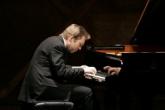 Currently touring the States, Leif Ove Andsnes’ recent recitals in Washington and New York have received rave reviews:
Currently touring the States, Leif Ove Andsnes’ recent recitals in Washington and New York have received rave reviews:
New York Times: “Putting together a thoughtfully varied recital program can be as difficult as playing your chosen pieces beautifully. The Norwegian pianist Leif Ove Andsnes demonstrated how to pull off both feats in his superb recital on Monday evening at Carnegie Hall. The phrase “solo recital” was first used by Liszt in 1840 to describe his solo concerts. Audiences and critics were baffled. How can someone “recite” with a piano? Yet that’s exactly what Liszt did by selecting works that together created the musical equivalent of a varied literary reading. Mr. Andsnes played no Liszt on Monday. But his program exemplified the Lisztian recital heritage. There were also no contemporary works, which, for me, usually suggests that a pianist is playing it safe. Not this time. Mr. Andsnes opened with a 25-minute selection of seldom-heard Sibelius piano pieces from the early 20th century, music so jarringly, wondrously strange that it was like hearing bracing new works … What could follow these Sibelius selections? Mr. Andsnes, who has been immersed in Beethoven’s concertos for the last few seasons, choose Beethoven’s Sonata No. 18 in E flat (Op. 31, No. 3), a playful, clearheaded piece that might seem a complete departure. But Mr. Andsnes conveyed the jolts of fervor beneath the impish surfaces. He dispatched the madcap finale with eerie coolness, even at a breathless tempo.”
New York Classical Review: “In the Debussy that led off the second half, the impeccable construction of Andsnes’s phrases was again the standout characteristic of his playing. In “La soirée dans Grenade” from Eastampes his lines were so natural and finely carved, they sounded almost like speech; in the flow of one line into the next, one could begin to hear a conversation ”
Washington Post: “Chopin and Debussy finished the program. Andsnes has been intently focused on Beethoven in recent years, but the four Debussy pieces (including three of the fiendishly difficult Etudes) suggest he is no less masterful in this repertoire. And his Chopin is thrilling, too, played with delicacy, nervous energy, and a spare, almost dry tone. Andsnes’s exceptional articulation — in music a bit like diction in speech, but essential to a range of effects, including color — serves him well in anything he plays. But in Chopin it can cause goose bumps. When Chopin repeats the haunting, opening melodic line in the Nocturne in F Major, Op. 15, No. 1, he ornaments it with two delicate triplet figures, wispy, inconsequential little things tossed off quickly and with no particular importance. Except there’s a world of finesse and grace in this kind of detail, and anyone who heard Andsnes play them Saturday knows that everything that matters about Chopin was there, concentrated and complete in eight little notes that collectively last perhaps a fraction of a second. Great artists, like Andsnes, make nanoseconds indelibly memorable.”